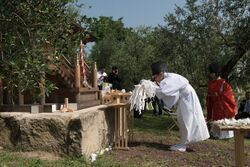Overseas Shinto
Topic: Religion
 From HandWiki - Reading time: 4 min
From HandWiki - Reading time: 4 min
Overseas Shinto designates the practice of the Japanese religion of Shinto outside Japan itself. Shinto has spread abroad by various methods, including the imperial expansion of the Empire of Japan during the Meiji period, the migration of Japanese to other countries, and the embrace of Shinto by various non-Japanese individuals.
Jinja outside Japan are termed kaigai jinja ("overseas shrines"), a term coined by Ogasawara Shozo (ja).[1]
In Europe
On June 22, 2014, Europe's first official Shinto Shrine: San Marino Shrine was opened in Serravalle, San Marino. The San Marino shrine was inaugurated in the presence of 150 personalities including the president of the Association of Shinto Shrines and Yoko Kishi, mother of the former Prime Minister of Japan Shinzō Abe and daughter of Prime Minister Nobusuke Kishi.[2][3] The shrine was established in commemoration of the victims of the 2011 Tōhoku earthquake and tsunami.[4]
In Asia
In Japanese-controlled territories (China, Korea, the Pacific Islands, Singapore, Taiwan, Manchukuo and Karafuto Prefecture), shrines were erected by both Japanese settlers and colonial authorities. Most of the sanctuaries were built by settlers, but many of them later received government recognition and funding. At first, jinja built Japanese communities for their use, often using ritual objects from their old shrines.[5][6][7] In 1900, the Japanese authorities erected the first large shrine in the colonies, it became Taiwan Grand Shrine. It was followed by other major shrines, such as Chōsen Shrine in Korea and Karafuto Shrine on Sakhalin. These shrines were built by decree of the governor and without consultation with the Shinto clergy, and their policies were determined by the military.[8][7][9]
In the Americas
United States
The first Shinto shrine in Hawaii was Hilo Daijingu (ja), built in 1898.[10] It is known that shortly before the attack on Pearl Harbor on December 7, 1941, Japanese Shintoists in Hawaii held ceremonies in honor of the former commander-in-chief of the Japanese fleet, Tōgō Heihachirō. One of the shrines, built at the beginning of the 20th century, was subordinate to both the Japanese authorities responsible for the shrine system and the American authorities, since it was registered in the state as a non-profit organization. American Shintoists were culturally influenced by their local environment. Thus, the spirits of George Washington and Hawaiian King Kamehameha I entered the local pantheon. After the attack on Pearl Harbor, the American government closed the shrine, fearing the growth of anti-American sentiment among the Japanese, but after the surrender of Japan in September 1945, the shrine continued its work. The few shrines on the West Coast of the United States were not restored after the war.[11][12]
Brazil
Two Shinto shrines were built in Brazil before the outbreak of World War II, both in the state of São Paulo. The first one was built in 1920 by Uetsuka Shuhei in the city of Promissão. The second temple was built by immigrants in the municipality of Bastos 18 years later. Most emigrants performed rituals of worshiping the gods with their families, and less often with their neighbors.[13] 11 major shrines are still located in Brazil.[14]
In Oceania
Micronesia
Shinto shrines dating from during or after World War II exist in some Micronesian countries.[15]
In Africa
Sub-Saharan Africa
Some Shinto-inspired new religions have gained ground in various cities in Sub-Saharan Africa.[16]
References
Citations
- ↑ Suga 2010, p. 48.
- ↑ San Marino. Sarà inaugurato questa mattina alle 10.30 al podere Lesignano, il San Marino Jinja
- ↑ "Un tempio shintoista a San Marino. E' il primo ufficiale in Europa". 2014-06-22. https://www.ilrestodelcarlino.it/rimini/cronaca/2014/06/22/1082095-san-marino-tempio-shintoista.shtml.
- ↑ Stefano Carrer (2014-05-25). "Shintoisti a San Marino". https://st.ilsole24ore.com/art/notizie/2014-05-25/shintoisti-san-marino-081510.shtml.
- ↑ Nakajima 2010, p. 22.
- ↑ Nakajima 2010, p. 30—32.
- ↑ 7.0 7.1 Hardacre 2017, pp. 431—432.
- ↑ Hardacre 2017, pp. 404—406.
- ↑ Nakajima 2010, p. 36.
- ↑ Shimizu, Karli (2019). "Religion and Secularism in Overseas Shinto Shrines: A Case Study on Hilo Daijingū, 1898–1941". Japanese Journal of Religious Studies 46 (1): 1–30. ISSN 0304-1042. Archived from the original on 2021-05-04. https://web.archive.org/web/20210504095834/https://www.jstor.org/stable/26854498.
- ↑ Hansen, Wilburn (2010). "Examining Prewar Togo Worship in Hawaii Toward Rethinking Hawaiian Shinto as a New Religion in America". Nova Religio 14 (1): 67–92. doi:10.1525/nr.2010.14.1.67. ISSN 1092-6690.
- ↑ Abe DK, Imamura A (2019). "The destruction of Shinto shrines in Hawaii and the West Coast during World War II: the lingering effects of Pearl Harbor and Japanese-American internment". Asian Anthropology 18 (4): 266–281. doi:10.1080/1683478X.2019.1592816. https://www.tandfonline.com/doi/full/10.1080/1683478X.2019.1592816.
- ↑ Frank Usarski, Rafael Shoji (2017). "Buddhism, Shinto and Japanese New Religions in Brazil". Handbook of Contemporary Religions in Brazil: 279–294. doi:10.1163/9789004322134_018. ISBN 9789004322134.
- ↑ Picken 2011, p. 274.
- ↑ Oskow, Noah (2020-07-13). "When Japan Ruled the Waves: The Forgotten Colonies of Micronesia" (in en-US). https://unseen-japan.com/japan-forgotten-colonies-micronesia/.
- ↑ Louveau, Frédérique (2020-07-06), "Japanese Spiritualities in Africa: From a Transnational Space to the Creation of a Local Lifestyle" (in en), Transnational Religious Spaces (Munich: De Gruyter), doi:10.1515/9783110690101-013/html, ISBN 978-3-11-069010-1, https://www.degruyter.com/document/doi/10.1515/9783110690101-013/html, retrieved 2024-01-25
Sources
- Earhart, H. Byron (2004). Japanese Religion: Unity and Diversity (fourth ed.). Belmont, CA: Wadsworth. ISBN 978-0-534-17694-5.
- Hardacre, Helen (2017). Shinto: A History. Oxford: Oxford University Press. ISBN 978-0-19-062171-1.
- Nakajima, Michio (2010). "Shinto Deities that Crossed the Sea: Japan's "Overseas Shrines," 1868 to 1945". Japanese Journal of Religious Studies. doi:10.18874/jjrs.37.1.2010.21-46.
- Picken, Stuart D. B. (2011). Historical Dictionary of Shinto (second ed.). Lanham: Scarecrow Press. ISBN 978-0-8108-7172-4.
- Suga, Kōji (2010). "A Concept of "Overseas Shinto Shrines": A Pantheistic Attempt by Ogasawara Shōzō and Its Limitations". Japanese Journal of Religious Studies 37 (1): 47–74.
 |
 KSF
KSF

